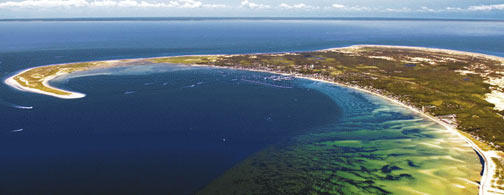Newport and Southern New England
These cruising grounds offer a pleasant combination of old New England villages, such as Edgartown and Nantucket, historical sites such as Plymouth with its replica Mayflower, cozy harbors such as landlocked Hadley Harbor and Cuttyhunk, outrageous cultures such as Provincetown's gay and lesbian and transgender and whatever community, and faux offshore destinations such as Block Island.
We cruised these waters in 2012, and they're a perennial favorite. We haven't gone back for a few years, because we love sailing in exotic, far-away waters. But there's no place like home, and we found a wonderful boat, so back we go.
Winds and Weather
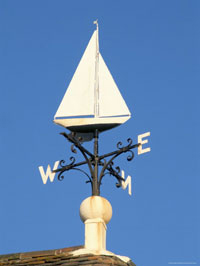
The prevailing winds are southwesterly 10-15 knots. The daytime temperature is 79° and the nighttime temperature is 66°. It can be rainy from time to time, of course, but fog is a rarity. For swimmers, the water temperature is 70°.
The Cruising Guide to the New England Coast (best cruising guide ever!) has a nice description of a typical day. "In midsummer, day after day will repeat the following pattern. In the morning it will be warm and quiet. Not a ripple will break the surface. The sky will be cloudless or thinly veiled with high cirrus. Later in the morning, as the land heats up, small, puffy clouds will appear over the land. Soon zephyrs from south or even southwest will come in, hauling soon to south-southwest or southwest. Then on the glassy water will appear cat's-paws and the ripples of the daily southwester, which may come at any time from shortly after dawn until noon. The arrival of this breeze is often dramatic. You may lie becalmed, sweltering in the heat, and slow roll for an hour. Then in the space of five minutes the sails fill, the temperature drops comfortably, and you are under way doing 3 or 4 knots with the calm forgotten. Close astern may lie another vessel, still becalmed. This breeze can increase to as much as 25 knots in some places."
Itinerary
As always, we won't have a fixed itinerary, except for the requirement to return to Newport at the end of the cruise. We'll invent our itinerary as we go, depending on crew preferences. We'll try to sample all that the area has to offer, included secluded anchorages and busy harbors, gourmet dining ashore and do-it-yourself dinners aboard, historical sites and whaling museums, the Cape Cod Canal and "offshore" passages. And, of course, the outrageousness of Provincetown. Here are descriptions of likely stopovers ...
Newport
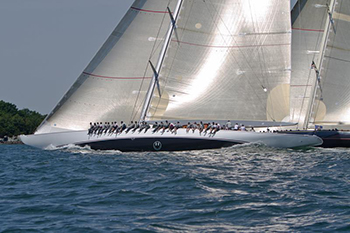
Our base of operations is not in Newport proper but in Fort Adams State Park, located at the mouth of Newport Harbor, offering spectacular panoramas of both the harbor and Narragansett Bay. The park is home to Fort Adams, the largest coastal fortification in the United States. The area was originally owned by William Brenton, who called the region "Hammersmith" after his home town in England. The name is perpetuated by the adjacent Hammersmith Farm, Jacqueline Bouvier Kennedy's childhood home and later President Kennedy's "summer White House." Annually, the park plays host to the Newport Jazz Festival and the Newport Folk Festival. Fort Adams State Park is also home to Newport's Museum of Yachting, which includes the 12-meter Courageous, two-time winner of the America's Cup under skippers Ted Hood and Ted Turner.
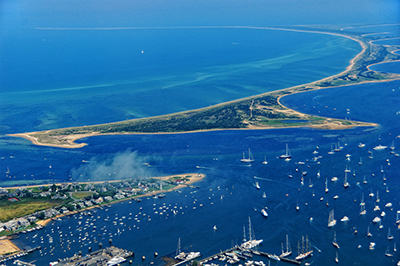
Newport is one of the principal summer resorts and yachting centers of the Atlantic coast. It boasts more colonial houses (about 400) than any other city in the country. You can visit the Casino, which houses the Tennis Hall of Fame, go see the first synagogue in the Americas, or take a stroll along Cliff Walk, a path that runs 3½ miles and provides splendid views of the Atlantic and backyard glimpses of some of Newport's great mansions (such as The Breakers).
Nantucket
Nantucket harbor is shown at right. The name may come from the Native American word "Natockete," meaning "faraway land." It's not that far away, but it is 30 miles south of Cape Cod and you can make believe that you're going offshore, if you want to. It dominated whaling in the early going, until supplanted by New Bedford around 1850 (Captain Ahab and his first mate Starbuck were Nantucketers). It's a pleasant destination with a nice New Englandy feel to it. Notable residents include Peter Benchley ("Jaws"), Tommy Hilfiger (trousers), and (formerly) Mr. Rogers.
Block Island
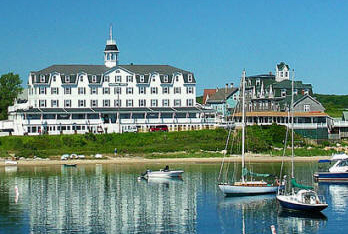
Reported by Giovanni da Verrazzano in 1524 (yes, he spelled it with two Z's) and rediscovered by the Dutchman Adriæn Block, the island is an easy passage from Newport. It is the quintessential summer island and a popular weekend destination among cruisers. On Block Island the yachtsman's favorite harbor is the so-called New Harbor, created in 1895 when a channel was dug that connected the Great Salt Pond to the ocean. It is such a popular place that commonly there are upward of 1500 boats anchored there during a summer weekend. Block Island is low-key, with hotels and inns but not much to see or do except a sight-seeing trip (bikes or taxi) past miles of moors, rolling hills, and magnificent sand dunes and cliffs, without a tree in sight. In the evening, a highlight is a pleasant walk across the island from New Harbor to Old Harbor and, after dinner at Ballard's Inn and a movie, back again.
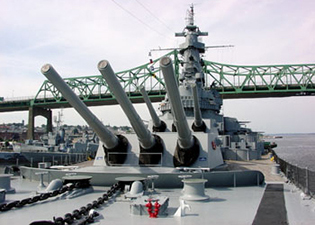
Fall River and Battleship Cove
A visit to Fall River is like a visit to a living museum. There is the Marine Museum and the Historical Society with an exhibit about Lizzie Borden and the world-famous ax murders in 1892. But the most popular tourist attraction is Battleship Cove. Visitors anchor in the cove and dinghy ashore to board and tour the nation's largest collection of U.S. Navy vessels open to the public in one location. Here are berthed the battleship Massachusetts (at right), the destroyer Kennedy, the submarine Lionfish, a landing craft, and PT 765. The Marine Museum includes a 12-foot model of the HMS Bounty, built for the movie Mutiny on the Bounty.
Elizabeth Islands (Cuttyhunk, Hadley Harbor)
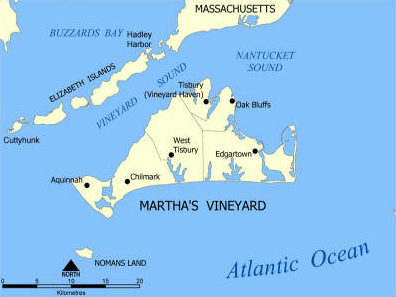
The Elizabeth Islands, named after Queen Elizabeth I, stretch across the mouth of Buzzards Bay, from Cuttyhunk to the west to Woods Hole in the east. The westernmost, Cuttyhunk, has always been a favorite destination of ours. It has a remote island quality composed of simplicity, bleakness, and independence. We always hike up the hill for a magnificent view of the island and its surrounding islands and waters. On a clear day you can see all the way up Buzzards Bay to the bridges across the Cape Cod Canal.
Hadley Harbor has also been a favorite destination, as it is one of the best protected and most attractive anchorages in the area. The surrounding islands are private, so one does not go ashore. One of them, Naushon Island, has been in the Forbes family for a great many years. It's inhabited by deer, sheep, and many species of birds, with a prominent classic house reminiscent of the house in Psycho, particularly when backlit by evening twilight with Mrs. Bates visible in profile on the widow's walk.
Martha's Vineyard
The two most interesting harbors on Martha's Vineyard are Edgartown and Oak Bluffs.
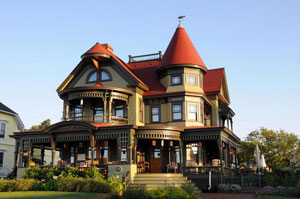
Edgartown, named for Edgar the son of James II, is a lively and picturesque town with a busy anchorage where you'll see some of the most elegant yachts of the Atlantic coast. Old buildings and narrow streets give Edgartown an antique flavor somewhat modified by boutiques, gift shops, and modern restaurants. In the eighteenth and nineteenth centuries, it was a successful whaling port. It's a brief ferry ride and a pleasant hike to the bridge on Chappaquiddick, where Ted Kennedy drove into the water, causing the death of his passenger Mary Jo Kopechne.
Oak Bluffs was famous in the nineteenth century as a camp-meeting center for religious groups. The old Methodist campground with its gingerbread cottages is a nice place to visit, and the town is heavily crowded with craftsmen, artists, and musicians.
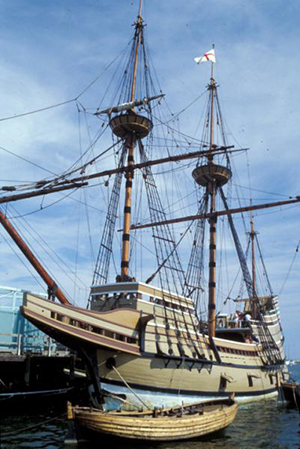
Plymouth
The narrow sinuous 2-mile channel into Plymouth makes one wonder how the original Mayflower ever made it in. Prominent in the harbor is Mayflower II (at right), a replica built in England in 1957 and sailed across by Captain Alan Villiers in 53 days. In Plymouth there are other museums and exhibits of colonial life, the most elaborate being Plimouth Plantation, a reconstruction of the Pilgrim settlement as it was in 1627.
Provincetown
P-town is known for its beaches, harbor, artists, tourist industry, and its counter-culture of gays and lesbians. It was where the Pilgrims first landed in 1620, and where they signed the Mayflower Compact before moving across Cape Cod Bay to Plymouth. Just getting to P-town involves something of an offshore experience, sailing across the expanse of Cape Cod Bay with a good chance of seeing whales, tuna, and offshore birds.The most prominent landmark is the Pilgrim Monument, a crenellated stone tower 348 feet tall and visible from Plymouth on a clear day. It's worth the climb to the top for a magnificent view of the harbor, the town, the hook of the Cape, and the back shore. One can walk across to the dunes or ride a rented bicycle on a paved bicycle path or, for a price, join a tour in a beach buggy. In the evenings, P-town is a sociological exhibit. The participants are of all ages, but mostly young, clad in a wide range of fashions from almost nothing to the most exotic. Language overheard bears little relation to schoolroom English. Rock and roll reaches far into the night from seaside dance clubs. The crowd mills and surges in and out of small shops, buying paintings, T-shirts, brass, pewter, leather goods, and a variety of (ahem) "alternative gifts."
